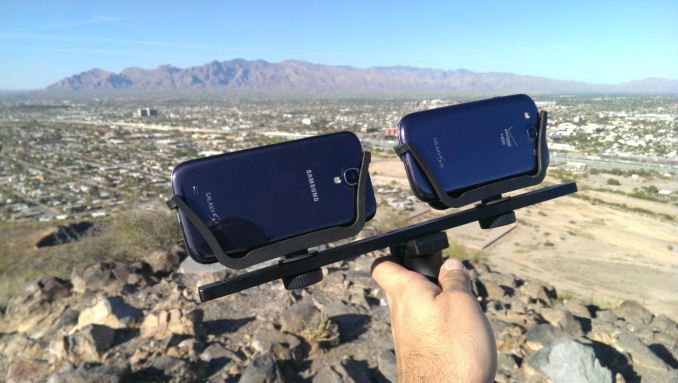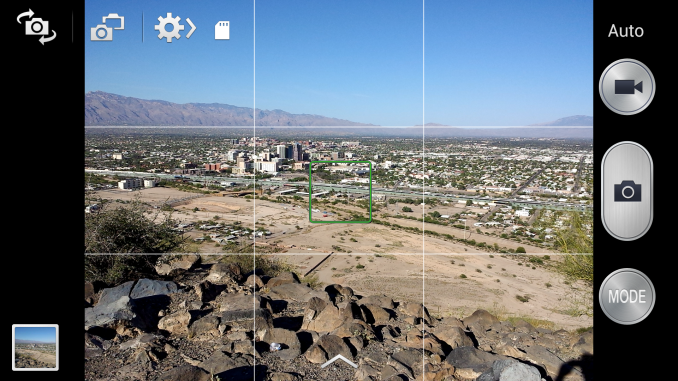Samsung Galaxy S 4 Review - Part 1
by Brian Klug on April 24, 2013 12:01 AM ESTCamera on SGS4
On the camera side Samsung is in an interesting position. The industry trend is overwhelmingly to go to more pixels and push the megapixel count up from 8 MP where most flagships sat last year to around 13 where they will sit this year. Samsung has to push that number to keep itself in a defensible and marketable position and at the same time deliver a camera experience that’s better than the previous year.
I published a table in the One review with the camera specifications from the previous generation. I’ve filled this in with confirmed information from the SGS4 review unit I have been taking samples with. With SGS4 Samsung does make some pretty considerable improvements, many of which undo some of the regressions that I described with SGS3. Focal length is now quite a bit longer, from the very wide SGS3 which was around 26mm in 35mm effective numbers, to 31 mm. This is a notable difference if you’re shooting with the two side by side, the SGS3 was always shockingly wide for a rear facing camera.
| Smartphone Camera Comparison - 2013 | |||||||
| HTC One | Samsung Galaxy S 2 | Samsung Galaxy S 3 | Samsung Galaxy S 4 | ||||
| Front Camera | 2.1MP | 2MP | 1.9MP | 2MP | |||
| Front Camera - CMOS |
OV2722 (1.4µm, 1/5.8") |
- |
S5K6A3 (1.75µm, 1/6") |
S5K6B2 (1.34µm, 1/6") |
|||
| Front Camera - Focal Length | ~1.59mm | 2.73mm | 2.7mm | 1.85mm | |||
| Front Camera - Max Aperture | F/2.0 | F/2.8 | F/2.8 | F/2.4 | |||
| Rear Camera | 4MP | 8MP | 8MP | 13MP | |||
| Rear Camera - CMOS |
ST VD6869 (2.0 µm, 1/3") |
S5K3H2YX (1.4µm 1/3.2") |
Sony/Samsung (1.4µm, ~1/3") |
IMX091PQ (1.12µm, 1/3.06") |
|||
| Rear Camera - Focal Length |
3.82mm (28mm eff) |
3.97mm (30mm eff) |
3.7mm (~26 mm eff) |
4.2mm (31 mm eff) |
|||
| Rear Camera - Max Aperture | F/2.0 | F/2.65 | F/2.6 | F/2.2 | |||
At the same time, F-number has improved dramatically, from the F/2.6 or 2.65 (I’ve seen both at times) aperture on the SGS3 to a much faster F/2.2. This dramatically improves the light collection abilities of the camera, by essentially a half stop. It’s difficult optical design to both keep the module thin enough to fit in the device without creating a huge bump (there’s a camera bump on SGS4, it’s there), increase focal length, improve F/#, and improve MTF for a better sensor all at the same time.
On the rear facing camera we see a Sony CMOS who continues to dominate the space, this time with an IMX091PQ sensor. On the front we Samsung’s own sensor, the S5K6B2 get used. Samsung also continues to go with a dedicated Fujitsu ISP inside the SGS4, this time it’s a new M10MO family which there isn’t a whole lot of information about. I suspect this continues to be done to mitigate the differences in SoC ISP between the APQ8064ab variant and Exynos 5 version and make tuning easier on Samsung’s camera team.
Imaging is increasingly a key differentiator for smartphones since it’s that device you always have on your person to take images with. For SGS4 camera is more of an emphasis this time around than it was with SGS3, which largely kept everything the same and just added software features. SGS4 brings better hardware and additional software features to do something with the hardware.
Outdoors in bright light the increased spatial resolution afforded from going from 8 MP to 13 MP helps. Samsung still does a lot of sharpening and there are halos around a ton of different features if you know where to look, but that’s the tuning they have opted for. I suspect we still are outresolving the sensor here, but I’m impressed with what I see with enough light. I took a lot of photos side by side with SGS3 and find SGS4 a notable improvement, but I’m not sure whether that’s just more damning commentary on SGS3 than anything else. I haven’t had time to put together many side by sides with buttons yet. I’ve been shooting with the HTC One on −2 sharpness since I prefer it that way, note that I accidentally left it this way with when making comparisons here since that’s still my daily driver until I can get an AT&T or T-Mobile SGS4 to use.
In lower light unsurprisingly we see the SGS4 offer better results than the SGS3 but still not quite as good as the HTC One. Samsung recently introduced low light shot on the SGS3 and Note 2, this feature carries over to the SGS4 but gets renamed back to Night Mode, even though behavior appears superficially to be the same. The SGS4 also introduces an auto night mode toggle, although this ships by default turned off. The mode automatically switches on night mode when it senses that you’re going to underexpose using the auto presets, I would advise basically leaving this on all the time. Unfortunately night mode introduces huge shot to shot latency that seems to be on the order of seconds — tap the button, capture runs, then there’s a progress bar that pops up while multiple exposures are ostensibly recombined into one image. You also have to be exceptionally steady to get an image without blur since it appears that this mode takes multiple images to get to the end goal — a better exposed image without tons of noise.
In the end there’s really no free lunch for anyone — you can temporally oversample (Samsung low light shot, or longer exposures with OIS like Nokia), or increase the size of your sampling area (larger pixels a-la HTC One), or do nothing and just give up unless you’re in a bright outdoor setting.
Samsung has introduced a bunch of new photo modes in the software on the SGS4, a number of which are actually pretty functional and awesome. There's the ability to create animated gifs from right in the camera, for example, where users paint a mask around the region they want animated from a short capture. This is essentially the same as Nokia's cinemagraph Lens from the Lumia 920, but it's still quite cool.
There's also dual camera, which lets you include a small overlay of the front facing camera atop the rear facing camera image. It initially struck me as a bit gimmicky but actually can be hilariously fun to share your face atop images to friends. It is also quite possibly the stuff of nightmares.
Panoramas on the SGS4 also are nicely put together and integrate continuously rather than get combined from a number of discrete images. The result is quite nice.
The user interface on SGS4 is a departure from the interface which has been present on previous Galaxy smartphones, and instead takes much UI/UX from the Galaxy Camera. Gone are the customizable toggles on the left side, instead options are in an expandable menu at the very top, and then another separate window. I got used to it pretty quickly but do miss the ability to customize the quick settings buttons on the left side and used to think that Samsung had the most powerful camera interface around. Things are moved around generally in a logical fashion however and I can understand how much this works to make transitioning between Galaxy Camera and SGS4 easy.
Video
When it comes to video, the SGS4 is records 1080p30 video at 17 Mbps H.264 High Profile.
I've done the usual thing and uploaded a sample to YouTube as well as our own servers for your inspection.
Video quality looks really nice and sharp on SGS4 from what I can tell by default. Anti shake (EIS in this case) is disabled out of the box, enabling it pops up a box warning you that stills captured during video record will be a different field of view.






























335 Comments
View All Comments
Roffles12 - Wednesday, April 24, 2013 - link
fans of the solid aluminum chasis are a very vocal and illogical minority. very annoying in fact. i have yet to hear any logical argument for why it's better. "it feels nicer in the hand" isn't a reason, but rather a completely subjective opinion. by my logical observation, the aluminum phones are actually more fragile and prone to scratching. aluminum is also more rigid which means it will have greater energy transfer on shock impact, resulting in a greater chance of shock energy transferring to the screen, thus damaging it. you're almost forced to purchase a case to protect it.i think the sales figures for the gs3 alone show that most people don't care if their phone looks like a piece of jewelery. please save your opinions of vanity for the imaginary fashion show in your head. i much prefer polycarbonate plastics for logical reasons. i've been using my gs3 for a year without a case and it looks just like new. if i want to be flashy, i'll wear my nicest watch. my phone is for functionality, so the gs3's build is par for the course. The 45 total second battery swap of a GS3/4 (thanks for flexible plastics) compared to 3.7 hour charging for the HTC One (thanks to a solid metal frame) is all that really needs to be said on the matter. case closed. argument over. shup up. go away.
Crono - Wednesday, April 24, 2013 - link
I like how you dismiss a view as being "a completely subjective opinion", then proceed to give your opinion, " i much prefer polycarbonate plastics", and conclude with a rather immature and unconvincing, "shup up. go away."Truth is some people prefer a solid aluminum body for the same reason one might prefer a more aesthetically premium vehicle. A phone is a tool, but when you are talking about high-end specs - and the GS4 is only marginally better CPU-wise in real-world, observable performance, about equal in other areas, and lower in some - a better quality chassis might make the difference.
I don't care if someone prefers the GS4 for whatever reason, but stop pretending (and apparently you are by virtually putting your fingers in your ears with that last comment) that Samsung doesn't make cheaper casing and without offering a lower price for the end consumer.
It's not even the fact that it's plastic or polycarbonate or whatever you want to call it, as Nokia and HTC make quality plastic bodies. There isn't a good excuse for cheap looking and feeling bodies, even if it's semi-durable without a third party case. This isn't the equivalent of an econobox in the car world, the Galaxy commands a high price.
If you really are satisfied with the Galaxy line, then feel free to complain when Samsung finally gets the message and decides to make truly premium-bodied phones: because they eventually will have to if HTC succeeds with the One.
Roffles12 - Wednesday, April 24, 2013 - link
There is nothing subjective about the fact that polycarbonate plastics and a better material choice for a hand held daily use device than aluminum because of its durability, elasticity, ability to absorb shock and ability to shape into different sizes and thickness while still maintaining those superior properties. I was obviously commentating on the weaknesses of aluminum in CONTRAST to polycarbonate materials. If you can't read between the lines of my comment and apply some common sense, then you need to go back to school. I'm done with you... go back to the verge where you can all have a circle jerk with your fragile tech jewelery.RealityMonster - Monday, April 29, 2013 - link
Actually, that's entirely subjective. The energy transfer argument is really only meaningful when you're talking about a device with moving parts or parts that are likely to break off because of the shock. The plastic back isn't really going to help the screen very much (that is, if the phone falls on its back, the screen isn't going to break, and if it falls on its front, the back isn't going to help), and there are very few parts inside the phone that are likely to move much at all given the impact. In fact, I see people with phones that have busted glass all the time, and the phone itself is still working. (I've seen both an SGS3 and an iPhone 4 working this way.)Plastic is more likely to shatter on impact (which is to say plastic shatters and aluminum won't), and if the plastic back falls and cracks, it probably won't snap back on anymore. On the MOHS hardness scale, aluminum is definitely higher than plastic, which means there are fewer things that can scratch it.
Maybe you don't think it's important what the body material is, but I don't think your bias against aluminum is particularly justified. Aluminum is going to have structural rigidity that the polycarbonate doesn't have, which is why you can use it structurally on the outside of the phone.
I'd actually like to know what the relative carbon footprint of the two materials is. On the one hand, aluminum has to be mined and machined, but plastic all comes from oil and I don't know if it's recyclable in this form. That's the sort of thing that I think is important.
Thegonagle - Wednesday, April 24, 2013 - link
Jeez, that's kind of like saying "it's annoying that people buy Cadillacs when Chevys do the same thing." It's a matter of style and differing taste.Kutark - Thursday, April 25, 2013 - link
Isn't rampant fanboism grand ;-).blau808 - Wednesday, April 24, 2013 - link
Giving up MicroSD and removable battery just for aluminium? Pffft.dyc4ha - Wednesday, April 24, 2013 - link
Why is it so hard for you people to understand that not everyone (I am comfortable in saying the majority) uses up ALL 32GB on their phone. Removable battery/External battery pack, both involves carrying an extra piece. I dont see the big difference here. Actually with the battery pack I can have undisrupted continuous use whereas removable battery requires that I switch off the phone and then replace the battery.jeffkibuule - Thursday, April 25, 2013 - link
Not only that, in order to charge the battery, it has to be in the phone. POINTLESS.ojchurch - Friday, April 26, 2013 - link
Have you never heard of external battery chargers?With an extra battery I can use my phone for 7/8 hours at work for updating spreadsheets, pdfs etc. on a building site with limited access to power and still have a spare battery for use in the evening. Or have a more "normal" usage pattern and not charge the phone for a couple of days. You have more freedom in how you can use your phone.